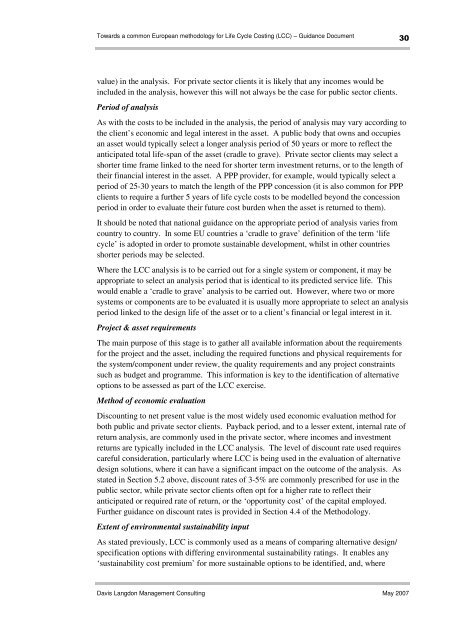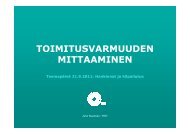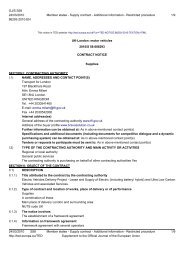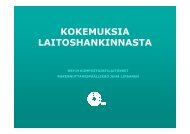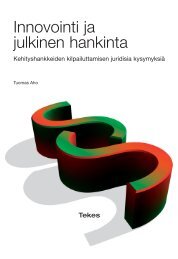Life cycle costing (LCC) as a contribution to sustainable construction ...
Life cycle costing (LCC) as a contribution to sustainable construction ...
Life cycle costing (LCC) as a contribution to sustainable construction ...
Create successful ePaper yourself
Turn your PDF publications into a flip-book with our unique Google optimized e-Paper software.
Towards a common European methodology for <strong>Life</strong> Cycle Costing (<strong>LCC</strong>) – Guidance Document<br />
30<br />
value) in the analysis. For private sec<strong>to</strong>r clients it is likely that any incomes would be<br />
included in the analysis, however this will not always be the c<strong>as</strong>e for public sec<strong>to</strong>r clients.<br />
Period of analysis<br />
As with the costs <strong>to</strong> be included in the analysis, the period of analysis may vary according <strong>to</strong><br />
the client’s economic and legal interest in the <strong>as</strong>set. A public body that owns and occupies<br />
an <strong>as</strong>set would typically select a longer analysis period of 50 years or more <strong>to</strong> reflect the<br />
anticipated <strong>to</strong>tal life-span of the <strong>as</strong>set (cradle <strong>to</strong> grave). Private sec<strong>to</strong>r clients may select a<br />
shorter time frame linked <strong>to</strong> the need for shorter term investment returns, or <strong>to</strong> the length of<br />
their financial interest in the <strong>as</strong>set. A PPP provider, for example, would typically select a<br />
period of 25-30 years <strong>to</strong> match the length of the PPP concession (it is also common for PPP<br />
clients <strong>to</strong> require a further 5 years of life <strong>cycle</strong> costs <strong>to</strong> be modelled beyond the concession<br />
period in order <strong>to</strong> evaluate their future cost burden when the <strong>as</strong>set is returned <strong>to</strong> them).<br />
It should be noted that national guidance on the appropriate period of analysis varies from<br />
country <strong>to</strong> country. In some EU countries a ‘cradle <strong>to</strong> grave’ definition of the term ‘life<br />
<strong>cycle</strong>’ is adopted in order <strong>to</strong> promote <strong>sustainable</strong> development, whilst in other countries<br />
shorter periods may be selected.<br />
Where the <strong>LCC</strong> analysis is <strong>to</strong> be carried out for a single system or component, it may be<br />
appropriate <strong>to</strong> select an analysis period that is identical <strong>to</strong> its predicted service life. This<br />
would enable a ‘cradle <strong>to</strong> grave’ analysis <strong>to</strong> be carried out. However, where two or more<br />
systems or components are <strong>to</strong> be evaluated it is usually more appropriate <strong>to</strong> select an analysis<br />
period linked <strong>to</strong> the design life of the <strong>as</strong>set or <strong>to</strong> a client’s financial or legal interest in it.<br />
Project & <strong>as</strong>set requirements<br />
The main purpose of this stage is <strong>to</strong> gather all available information about the requirements<br />
for the project and the <strong>as</strong>set, including the required functions and physical requirements for<br />
the system/component under review, the quality requirements and any project constraints<br />
such <strong>as</strong> budget and programme. This information is key <strong>to</strong> the identification of alternative<br />
options <strong>to</strong> be <strong>as</strong>sessed <strong>as</strong> part of the <strong>LCC</strong> exercise.<br />
Method of economic evaluation<br />
Discounting <strong>to</strong> net present value is the most widely used economic evaluation method for<br />
both public and private sec<strong>to</strong>r clients. Payback period, and <strong>to</strong> a lesser extent, internal rate of<br />
return analysis, are commonly used in the private sec<strong>to</strong>r, where incomes and investment<br />
returns are typically included in the <strong>LCC</strong> analysis. The level of discount rate used requires<br />
careful consideration, particularly where <strong>LCC</strong> is being used in the evaluation of alternative<br />
design solutions, where it can have a significant impact on the outcome of the analysis. As<br />
stated in Section 5.2 above, discount rates of 3-5% are commonly prescribed for use in the<br />
public sec<strong>to</strong>r, while private sec<strong>to</strong>r clients often opt for a higher rate <strong>to</strong> reflect their<br />
anticipated or required rate of return, or the ‘opportunity cost’ of the capital employed.<br />
Further guidance on discount rates is provided in Section 4.4 of the Methodology.<br />
Extent of environmental sustainability input<br />
As stated previously, <strong>LCC</strong> is commonly used <strong>as</strong> a means of comparing alternative design/<br />
specification options with differing environmental sustainability ratings. It enables any<br />
‘sustainability cost premium’ for more <strong>sustainable</strong> options <strong>to</strong> be identified, and, where<br />
Davis Langdon Management Consulting May 2007


